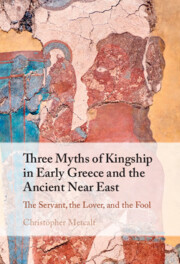62 results

Three Myths of Kingship in Early Greece and the Ancient Near East
- The Servant, the Lover, and the Fool
-
- Published online:
- 19 December 2024
- Print publication:
- 02 January 2025
Chapter 3 - Vergil’s Ecological Poem
-
- Book:
- The Environmental Poetry of Augustan Rome
- Published online:
- 12 December 2024
- Print publication:
- 19 December 2024, pp 98-145
-
- Chapter
- Export citation
8 - A Brief History of Epic Time
- from Part III - Epic Time
-
-
- Book:
- The Cambridge Companion to Ancient Greek Epic
- Published online:
- 04 December 2024
- Print publication:
- 28 November 2024, pp 169-183
-
- Chapter
- Export citation
3 - Didactic (and) Epic
- from Part I - Epic Engagements
-
-
- Book:
- The Cambridge Companion to Ancient Greek Epic
- Published online:
- 04 December 2024
- Print publication:
- 28 November 2024, pp 58-78
-
- Chapter
- Export citation
6 - Epic Dislocation
- from Part II - Epic Space
-
-
- Book:
- The Cambridge Companion to Ancient Greek Epic
- Published online:
- 04 December 2024
- Print publication:
- 28 November 2024, pp 130-146
-
- Chapter
- Export citation
1 - Greek and Near Eastern Epic
- from Part I - Epic Engagements
-
-
- Book:
- The Cambridge Companion to Ancient Greek Epic
- Published online:
- 04 December 2024
- Print publication:
- 28 November 2024, pp 17-40
-
- Chapter
- Export citation
5 - Do Not Talk Death to Me
- from Part II - Epic Space
-
-
- Book:
- The Cambridge Companion to Ancient Greek Epic
- Published online:
- 04 December 2024
- Print publication:
- 28 November 2024, pp 104-129
-
- Chapter
- Export citation
11 - Asian Goddesses and Bees
- from Part III - Anatolian and Aeolian Myth and Cult
-
- Book:
- Aeolic and Aeolians
- Published online:
- 21 November 2024
- Print publication:
- 21 November 2024, pp 317-343
-
- Chapter
- Export citation
10 - Boeotian Foundation Mûthoi: From Dioscuri to Cabiri
- from Part II - Aeolian Origins in Myth
-
- Book:
- Aeolic and Aeolians
- Published online:
- 21 November 2024
- Print publication:
- 21 November 2024, pp 277-314
-
- Chapter
- Export citation
Chapter 5 - To Educate and to Entertain: Didactic and the Arrangement of Knowledge
-
- Book:
- A History of Latin Literature From its Beginnings to the Age of Augustus
- Published online:
- 14 November 2024
- Print publication:
- 21 November 2024, pp 148-197
-
- Chapter
- Export citation
17 - Conclusion
- from Part III - Anatolian and Aeolian Myth and Cult
-
- Book:
- Aeolic and Aeolians
- Published online:
- 21 November 2024
- Print publication:
- 21 November 2024, pp 519-552
-
- Chapter
- Export citation
15 - Honey and Theogonies: The West Face of Sipylus
- from Part III - Anatolian and Aeolian Myth and Cult
-
- Book:
- Aeolic and Aeolians
- Published online:
- 21 November 2024
- Print publication:
- 21 November 2024, pp 450-481
-
- Chapter
- Export citation
13 - Aia and Argonauts
- from Part III - Anatolian and Aeolian Myth and Cult
-
- Book:
- Aeolic and Aeolians
- Published online:
- 21 November 2024
- Print publication:
- 21 November 2024, pp 375-409
-
- Chapter
- Export citation
6 - Pindar, Bacchylides, Archaic Epic, and Intertextuality
- from Part II - Lyric and Epic
-
-
- Book:
- Texts and Intertexts in Archaic and Classical Greece
- Published online:
- 14 November 2024
- Print publication:
- 21 November 2024, pp 138-166
-
- Chapter
- Export citation
7 - Aeolian Self-Identity and Metapontium
- from Part II - Aeolian Origins in Myth
-
- Book:
- Aeolic and Aeolians
- Published online:
- 21 November 2024
- Print publication:
- 21 November 2024, pp 179-210
-
- Chapter
- Export citation
2 - The Wisdom of Archilochus
- from Part I - Early Intertextuality
-
-
- Book:
- Texts and Intertexts in Archaic and Classical Greece
- Published online:
- 14 November 2024
- Print publication:
- 21 November 2024, pp 51-72
-
- Chapter
- Export citation
14 - Parnassian Divining Bee Nymphs and Lot-Divination
- from Part III - Anatolian and Aeolian Myth and Cult
-
- Book:
- Aeolic and Aeolians
- Published online:
- 21 November 2024
- Print publication:
- 21 November 2024, pp 410-449
-
- Chapter
- Export citation
3 - Hybrids around the Corrupting Sea
-
- Book:
- Centaurs and Snake-Kings
- Published online:
- 16 August 2024
- Print publication:
- 25 July 2024, pp 57-91
-
- Chapter
- Export citation
Chapter 2 - The Proem to On Nature
-
- Book:
- Reconstructing Empedocles' Thought
- Published online:
- 01 February 2024
- Print publication:
- 08 February 2024, pp 62-137
-
- Chapter
- Export citation
HERMESIANAX'S POETICS OF LOVE IN CONTEXT
-
- Journal:
- The Classical Quarterly / Volume 73 / Issue 2 / December 2023
- Published online by Cambridge University Press:
- 03 April 2024, pp. 620-629
- Print publication:
- December 2023
-
- Article
-
- You have access
- Open access
- HTML
- Export citation


